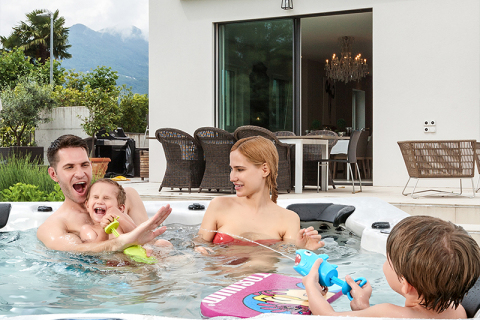
- Home
- >
News
The inventor of the modern Jacuzzi tub is: Roy Jacuzzi Roy Jacuzzi is a member of the Jacuzzi company and its most important technology driver and spa equipment innovator. He and another key engineer at the company, Peter Kosta, developed the world's first truly integrated jet-powered Whirlpool Bath.
1. First, add an antifoaming agent – to quickly remove surface foam; 2. Then test and adjust the pH, alkalinity, and chlorine level – to restore chemical balance; 3. Add a cleaning enzyme – to break down grease and organic matter; 4. If necessary, replace part or all of the water – to eliminate the source of foam at its root.
The answer is: not necessarily. While calcium ions can indeed combine with carbonate and bicarbonate ions under certain conditions to form calcium carbonate precipitate, making the water appear whitish or cloudy, the degree of turbidity in spa jacuzzi bathtub water does not accurately reflect calcium content.
Many users believe that having enough manpower is sufficient for moving a freestanding spa jacuzzi bathtub. In reality, this is one of the most common and dangerous mistakes. There are three reasons: 1. Uneven weight distribution 2. Large size and high center of gravity 3. Lack of specialized tools
Add the following to the water: • Professional bathtub drain cleaner (or a mixture of white vinegar and baking soda); • Add as directed and stir well. Turn on all nozzles and the circulation pump, allowing the system to run for 15-20 minutes. This process will thoroughly flush out mold, slime, and impurities adhering to the pipes.
The standard design load-bearing capacity of residential floors is typically 200–300 kg/m². If the spa jacuzzi tub has a small base area, for example, only 2 square meters, but the total weight reaches 800 kg, then the load-bearing capacity per unit area is as high as 400 kg/m², exceeding the normal safe range.
When the pH exceeds 8.0, carbonates precipitate under heating conditions, forming tiny suspended particles. These particles adhere to the foam interface, making the foam stronger and harder to dissipate. Therefore, high pH itself is not a "foam maker," but it is a "foam maintainer."
When we soak in the hot water of a spa jacuzzi bathtub for an extended period, some of the skin's natural oils are removed, and moisture is lost from the stratum corneum, weakening the skin's protective barrier and causing keratinocytes to loosen and shed. This physiological reaction is more pronounced in winter or in people with sensitive skin.
In a spa jacuzzi tub, the surrounding air humidity is high, making it difficult for the body to perceive moisture loss. Even if the body is "sweating," the warm, humid environment causes the sweat to quickly mix with water, so we don't feel it. However, the body's internal water is continuously decreasing through metabolism.
Not necessarily safe; it depends on the source of the foam and the water quality. If the foam is caused by residues of shampoo, conditioner, or detergents, it may contain fragrances, surfactants, etc., which can cause redness, itching, or contact dermatitis with prolonged contact or for those with sensitive skin.
In public, wearing a swimsuit is undoubtedly the safest option to respect others, maintain health, and maintain etiquette. In private, however, you can choose whether to wear one based on your personal preference. The ultimate goal is to ensure a comfortable and safe spa jacuzzi bathtub experience that is both personal and appropriate.
The requirement that a spa jacuzzi bathtub must be perfectly level stems from a comprehensive consideration of equipment performance, user safety, pump efficiency, and long-term maintenance costs. Whether for home or commercial use, the installation process must strictly adhere to leveling requirements. Never overlook this seemingly minor, yet crucial, technical step.












